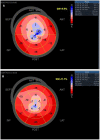The follow-up of myocardial injury and left ventricular function after spontaneous coronary artery dissection
- PMID: 38034376
- PMCID: PMC10682093
- DOI: 10.3389/fcvm.2023.1276347
The follow-up of myocardial injury and left ventricular function after spontaneous coronary artery dissection
Abstract
Monitoring patients with spontaneous coronary dissection (SCAD) is critical in their care, as there are no accepted recommendations. To this end, finding clinical or imaging predictors of recurrent events in these patients is essential for predicting adverse events and guiding treatment decisions between conservative medical therapy and percutaneous coronary intervention. Myocardial injury and left ventricular function after SCAD can be variable parameters that require monitoring. Echocardiography and cardiac magnetic resonance are two useful imaging techniques to do so. This review aims to analyze previously published results on monitoring myocardial injury and left ventricular function in SCAD patients while highlighting the potential benefits of contemporary imaging techniques that could further improve patient care in the future.
Keywords: cardiac magnetic resonance; echocardiography; follow-up; left ventricular function; myocardial injury; spontaneous coronary artery dissection.
© 2023 Krljanac, Apostolovic, Polovina, Maksimovic, Nedeljkovic Arsenovic, Djordjevic, Stankovic, Savic, Djokovic, Viduljevic, Stankovic and Asanin.
Conflict of interest statement
The authors declare that the research was conducted in the absence of any commercial or financial relationships that could be construed as a potential conflict of interest.
Figures







References
Publication types
LinkOut - more resources
Full Text Sources

